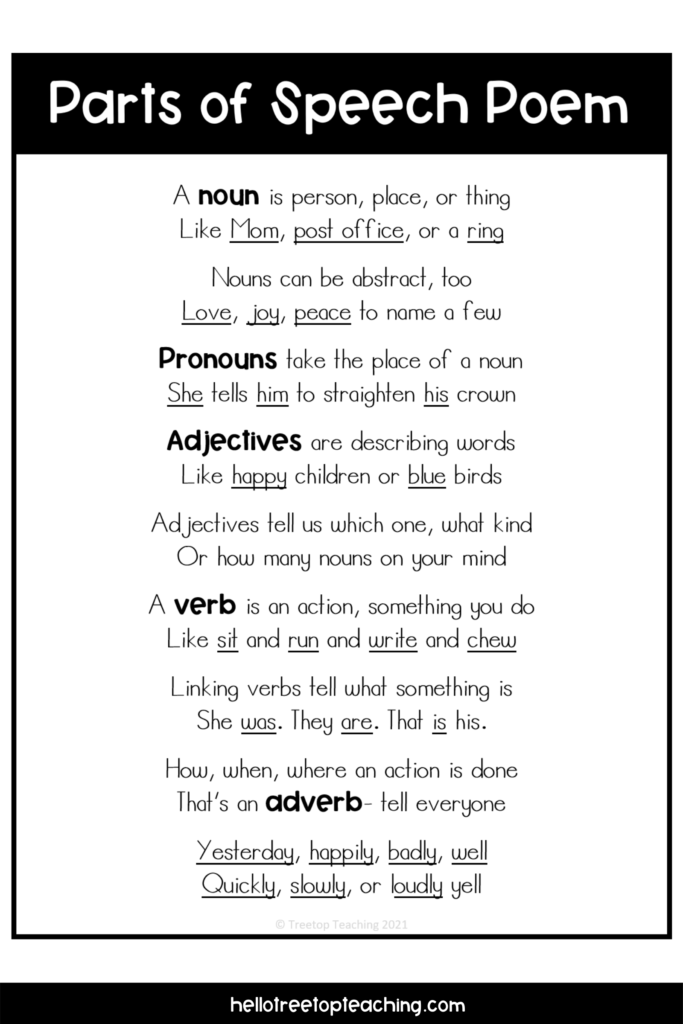Why are the Eight Parts of Speech Important?
When I first sat down to teach the 8 parts of speech I thought,
“This will be a quick easy lesson. Just a few weeks of review, and we can move on.”
I taught the lessons as normal. We did a few cut and paste activities here and there, and I figured we could move on. It wasn’t until a few weeks later when we were looking at something, and I said, “Oh! This is an awesome word! Who can tell me what part of speech it is?”
It took the students 6 guesses to get the correct part of speech (There are only 8 to choose from🤨!) I knew right then that there had to be a different way to teach the eight parts of speech.
The End Goal
The more I researched and the more I tried things in my own classroom, the more I realized that it is small chunks of daily practice and genuine discussion that was really going to help my students not just memorize the definitions for parts of speech, but really master them. As I watched my students grasp the parts of speech in ways like never before, their writing began to skyrocket. As we read great books together, they were noting powerful verbs and descriptive adjectives which easily found their way into their own writing. This is the end goal.
Knowing parts of speech gives a common language when you are instructing students in writing. These steps created students who were always on the hunt for good words that they could add to their own writing. They become observant readers and confident writers.
I assembled five essential steps to take students from just knowing definitions, to becoming better writers. These steps (and freebies for EVERY step of the way🎉) are included in this free download.
Below are the steps I took to bring my students to full mastery of the 8 parts of speech with just 10-15 minutes a day of practice. Remember the ultimate goal is to create independent learners and confident writers. Each step is working toward both of those things.
1. Posters for the 8 Parts of Speech
Classroom Display
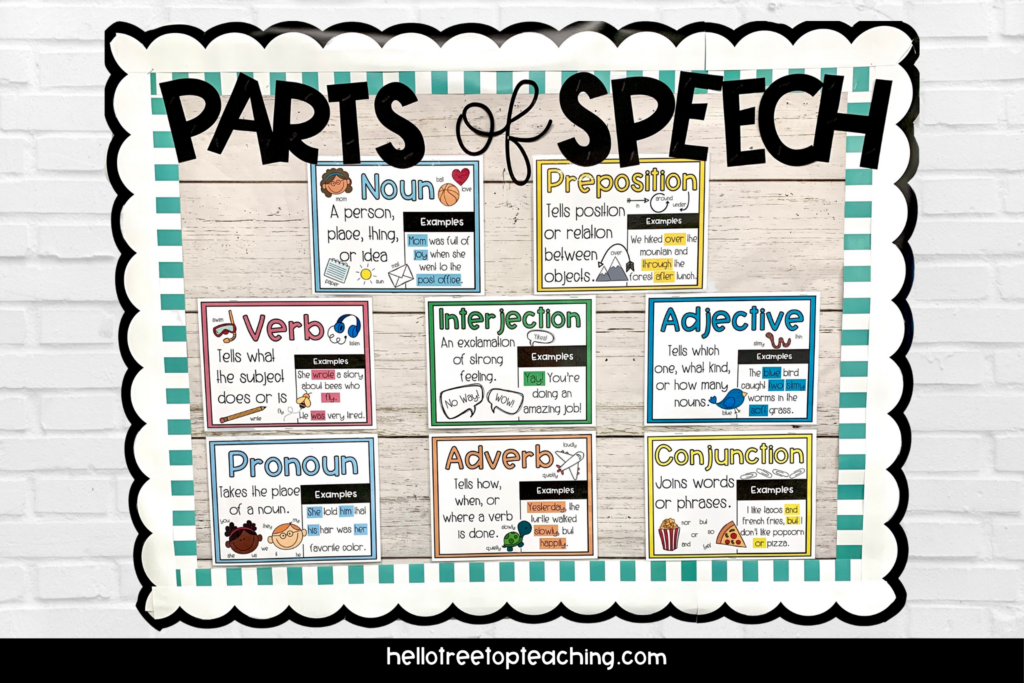
Now this may be an unpopular opinion, but I love creating bulletin boards. There is just something about new paper and those layers borders that get my teacher heart going.
It is important, however, that the bulletin boards are not just beautiful and eye-catching, but also serve your students in some way. The words on your bulletin board should be big enough for students to read. Most importantly, the students should be able to access the information without much help from the teacher.
I also know that these beautiful bulletin boards can be very time-consuming. The best option is to have paper size pieces, so they are easy to print and assemble. This allows you to easily put up and switch out the bulletin board in a matter of minutes.
You can get this bulletin board display for the 8 parts of speech for free in this download. And the best part? You can easily store these in a safe place and throw them back up on the bulletin board next year.
Individual Students Reference
The bulletin boards are a great student reference, but there is something I have found to be even more successful as a reference tool- individual reference materials with students input!
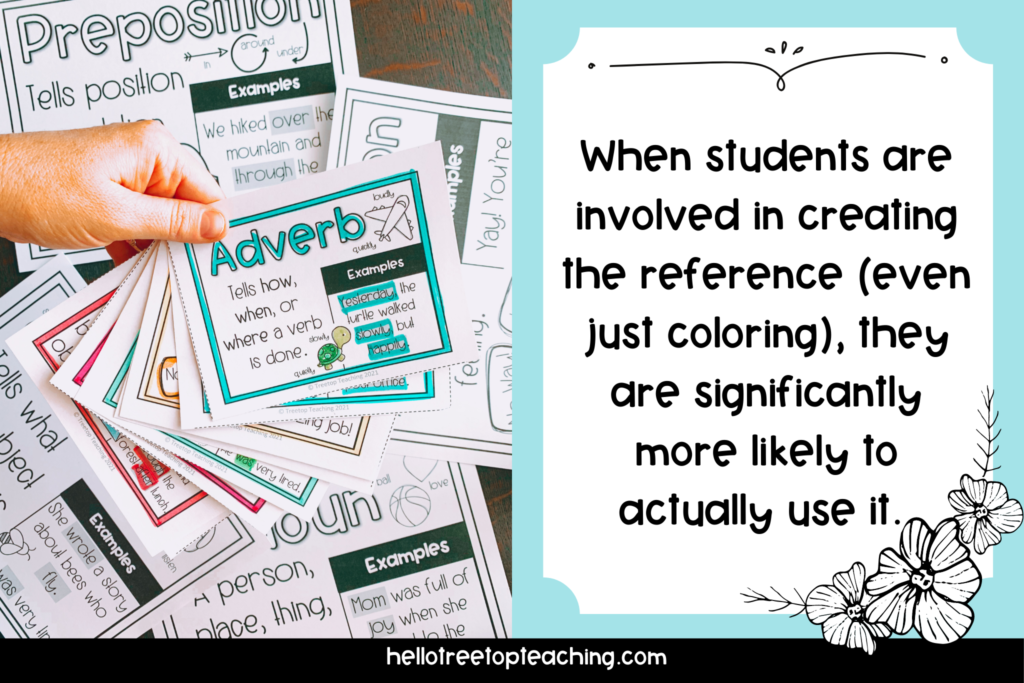
Using smaller versions of the 8 parts of speech posters are perfect to keep at student desks (using these sticky hooks on the side of the desks), small group table, or literacy stations. I printed mine on cardstock, laminated them, hole-punched them, and placed them on a binder ring. These sets have lasted three years of student use in my room.
Some students may be slow to memorize, and these smaller individual student references for parts of speech help to build the confidence of students as they work on individual or small-group tasks. The anxiety of not knowing is easily diminished with easy to access guide right at their fingertips. And even when you’re ready to switch out the large classroom display bulletin board, students will still have access to the information they need.
A Step Further
Want to take it a step further? You could even have students create their own small reference cards or reference sheet. Students who are involved in creating a reference are more likely to pull it out and use it when they get stuck.
I use these small cards in my classroom and print them on card stock in black and white. I let the students color them and make them their own. Then throughout the lessons I have the students look for examples of the parts of speech in all different subject areas and even the books that they’re reading. They write these examples on the backs of the cards and once we have enough examples, then I laminate them. I have the students cut them out and put them on the ring to save my prep time.
Because the students were involved, they will go back and pull out these cards all year long👏🏼. I also make sure to have a hook stuck on the side of their desk. This way they can easily grab the ring of cards and use the information anytime.
2. Identify Parts of Speech in Sentences
Want to truly assess how much your students know what it comes to the 8 parts of speech? Pull a sentence from any book and write it up on your classroom whiteboard. Then tell the students that there are blank number of nouns and ask them to find them. Treating this lesson like a scavenger hunt gets students engaged and excited for parts of speech. Every sentence is going to have something new, different, and probably tricky that will need to be addressed.
Classroom Discussion
The best benefit of labeling sentences with parts of speech is the discussion that occurs. I have stood in front of my class and asked them to give me a noun. Without a doubt one student will raise their hand and say something like “run”. Now most of the students in the class at this point are shaking their head thinking “run” is a verb. But the truth is “run” CAN be a noun, and this is where the magic happens in classroom discussion.
Labeling the 8 Parts of Speech in Sentences
You can use any sentence from any book or article and have students locate the parts of speech to prompt this natural and organic discussion. Usually, I like to give my students a checklist of things to find in the sentence. I may tell them that this sentence has three nouns, two verbs, one adjective, etc., and write this checklist up on the board before having students volunteer to come up and label the sentence.
I also like each student to have a copy of the sentence and checklist on paper in front of them. This allows them to not only listen and watch the board, but also copy the information down onto their paper. They’re often not enough words in the sentences for every student to be able to label something on the board. By giving them a hard copy to label on their desk, I ensure that every student is able to participate. I hand the sentence to the students and give them ONE minute (on a timer) to try to find as many things as they can. Then we start to go over it together on the board together.
What I love most about this activity is that it only takes 10 minutes. The sentence goes up on the board and they have one minute to try to find as much as they can. After the timer goes off, I start drawing sticks (or calling on volunteers) to call students to the board to label something from the sentence. The students still sitting at their desks are checking their work and filling in anything that they missed.
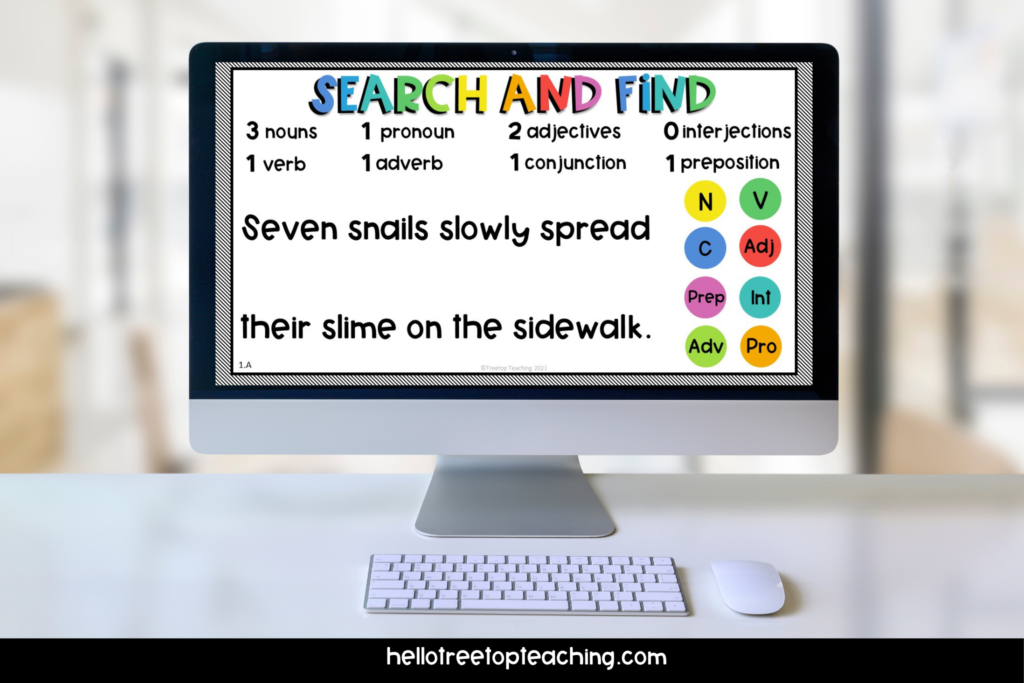
During distance learning I needed to find a way to recreate this activity for my students. I created a digital version of this activity where students click and drag labels over the words in a sentence. We aren’t still doing distance learning (thank GOD🙌🏼). However, I still project the slides on my whiteboard to use as our sentence of the day. Or occasionally I’ll assign them to students in Google Classroom. If you want to try this out in your classroom, you can get five free sentences with student handouts and a teaching guide with discussion points in this FREE download.
3. Make the 8 Parts of Speech Fun
Now that students have had a lot of time to interact with the parts of speech in their natural form in sentences, they’re ready to practice in some new and fun ways. Below are a collection of my favorite activities that I use in my classroom for students to practice. You can download a FREE copy of each of these activities to start using with your class today.
Parts of Speech Poem
I highly encourage you to find a poem for the parts of speech because it is incredibly engaging for the students. When I’m looking for a poem (or song), I want to make sure it has definitions for each part of speech, but also examples for the students to have. I also love to add motions and ask the students for their input. Making it so that the students are part of the creation process means they will be more likely to participate with enthusiasm when reciting the poem. I have included a copy of the poem I wrote for the 8 parts of speech in this FREE download.
DIY Sentences

Another fun activity I’ve seen really help students grasp and memorize the parts of speech is do-it-yourself sentences. I will write different parts of speech on the board in a pattern and ask students to write a sentence that would fit. We start off very easy with just three or four word sentences and work our way up. This is a great activity to do in small groups because it is so simple to differentiate. The best part about this activity is that it doesn’t require any prep or materials while still engaging students..
Color by the 8 Parts of Speech
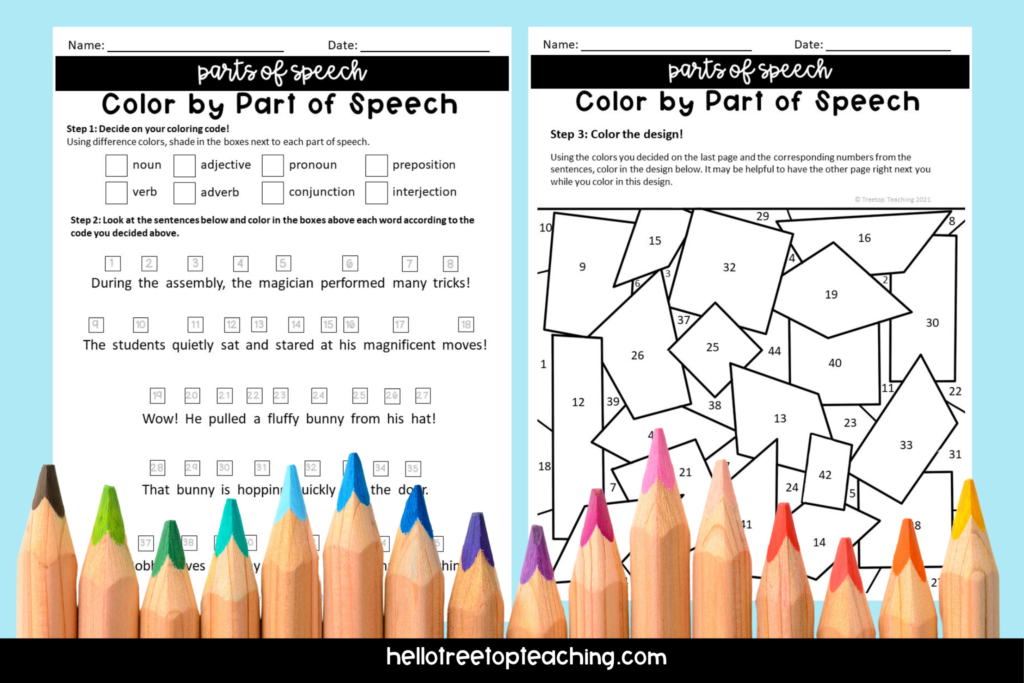
Coloring by Part of Speech makes them fun for students because who doesn’t love coloring (especially in Upper Elementary. As soon as I ask the students to get their colored pencils, you can feel the energy in the room spike.
You can easily create your own color by part of speech worksheet. Just find a coloring sheet in a coloring book or online and use a pen to write in different words. Then create a coloring key at the top or the bottom of the page before making copies for the students. I used this activity for seat work, morning work, and even sometimes in word work or literacy stations. And yes, a freebie for this is also included in the download!
Mad Libs with Parts of Speech
This Mad Libs activity works best in whole group or small group settings. First, I have students make cards for the different parts of speech. I may have them make six cards for nouns, five for verbs, etc. Then we create one pile for each part of speech to use with a story that has some missing words. When we get to a blank that says “noun”, we shuffle the noun cards and pull out a noun to write in. We do this with all the blanks on the page and it always creates a silly story.
This is a fun morning meeting or small group activity, but really students can do this in small groups of just their peers. You can easily create this activity yourself by just having students use note cards for the parts of speech cards and then finding a small story to white out some of the words. But if you don’t feel like creating your own, there is a free sample in this download.
4. Make Finding the 8 Parts of Speech Natural
After students have mastered the definitions for parts of speech and had some fun interacting with them in new and creative ways, it’s important to make that jump away from “this is a parts of speech activity” to a natural discovery and collection of the words throughout all subject areas. This isn’t a separate activity- it is an integration into every subject and the way that you teach. This means we’re looking at a math worksheet and I’m asking the students to find three verbs in word problems. This is looking at a map in social studies and noticing that the places are all nouns. This will take modeling on the part of the teacher and also some scaffolding to get the students to do this and notice these things on their own.

Finding the 8 Parts of Speech While Reading
After students have some modeling by the teacher, they’re ready to go on the hunt on their own. I like to start by having the students get in groups. Each group uses the same paragraph or article to hunt through to find the different parts of speech. This is a great way to start because we can all come back together as a class and discuss.
As time goes on I want the students up to be able to pick up their free reading book and fill out a collection sheet for independently. This doesn’t mean that I stop asking questions on the math worksheet about parts of speech, or that I stop engaging and modeling this discovery for the students. However, I am moving them toward a more independent discovery and collection of the words.
5. Integrate the 8 Parts of Speech into Writing
Have Students Build a Parts of Speech List
Your students now have experience not just knowing the 8 parts of speech but actually finding and discussing them among their peers. They’re now ready to apply what they have learned to their writing which was always the end goal.
When I’m starting to tie this into writing, I give the students blank pages to curate word lists from writers and authors they admire.
The students make the jump from:
- finding parts of speech in a sentence
- to just finding any parts of speech while they’re reading
- to now finally being selective in the parts of speech that they find
- and sorting them into categories for later use.
Again, having students participate in the making of a reference material means they are much more likely to pick it up and use it.
Use a Writing Checklist
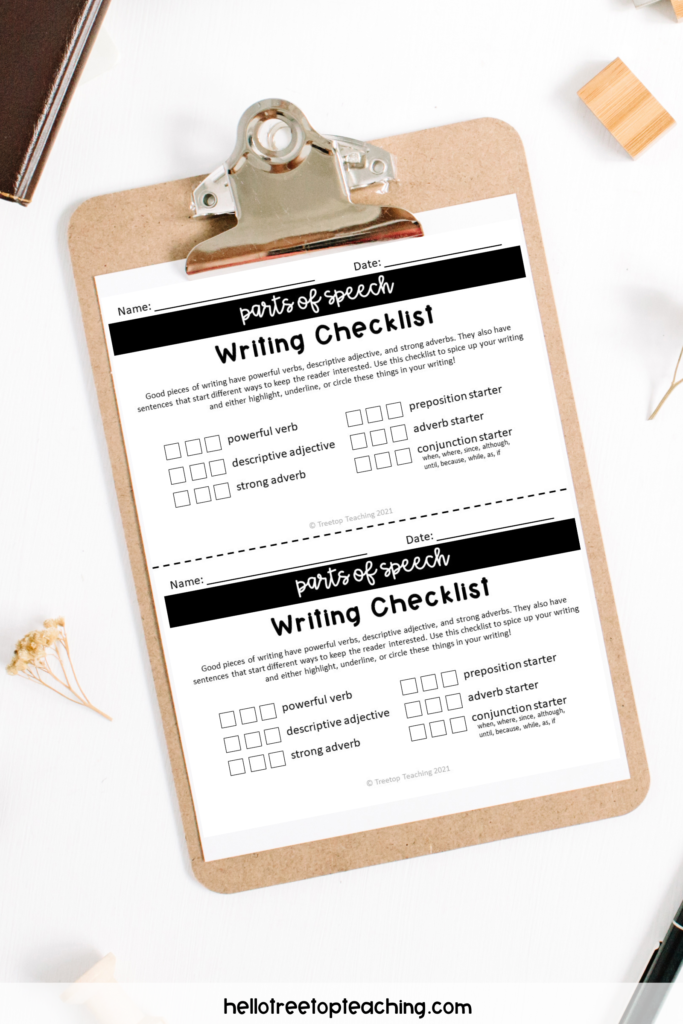
Once the students have some good lists, they are ready for a writing checklist. This checklist does not include things like capitalization, punctuation, or spelling (although those things are very important). Rather it includes things that are going to spice up their writing. On the checklist that I created for my students you will find powerful verbs, descriptive adjectives, and strong adverbs. You will also find a list of ways that students can start their sentences with prepositional phrases, clausal/subordinating conjunctions, and strong adverbs. Students began to see this connection between the parts of speech words they’ve collected and good quality writing.
Posts to Read Next:
Fun Ways To Teach Parts of Speech– This post is geared toward homeschooling, but has several fun parts of speech activities that involve movement!
Eight Parts of Speech Reivew- Jack Hartmann– This is a YouTube video and rap style song that introduces and defines the 8 parts of speech with examples.
How to Teach Parts of Speech So They Stick– This post by Hannah at The Classroom Key includes an amazing visual map for the 8 parts of speech and some cute songs and poems.
Get the Freebies for All 5 Steps to Parts of Speech Mastery
The eight parts of speech used to be mini lessons that I squeezed in here and there. But now that I’ve seen the impact of mastering parts of speech on my students’ writing, I will never go back.
Whether it is:
- fun poems to start off our class time
- 10-minute authentic discussions and sentence dissections
- playing Mad Libs and laughing just as hard as the kids
- or collecting quality words that my students are passionate about adding into their writing
I have seen firsthand the impact of an in-depth study on the eight parts of speech has had on students. It doesn’t have to be boring or time-consuming. It can be a simple, yet effective tool when it comes to creating observant readers and confident writers.
If you’re feeling a bit overwhelmed by all of these steps and just not sure where to start, this is for you. You can download this free step-by-step guide that will walk you through The 5 Steps to Effectively Helping your Students Master the Eight Parts of Speech with freebies included for ALL 5 steps. You can download this guide below and start implementing it in your classroom today!
Some of the links below in this desk pets blog post are affiliate links. This means that, at zero cost to you, I will earn an affiliate commission if you click through the link and finalize a purchase.


